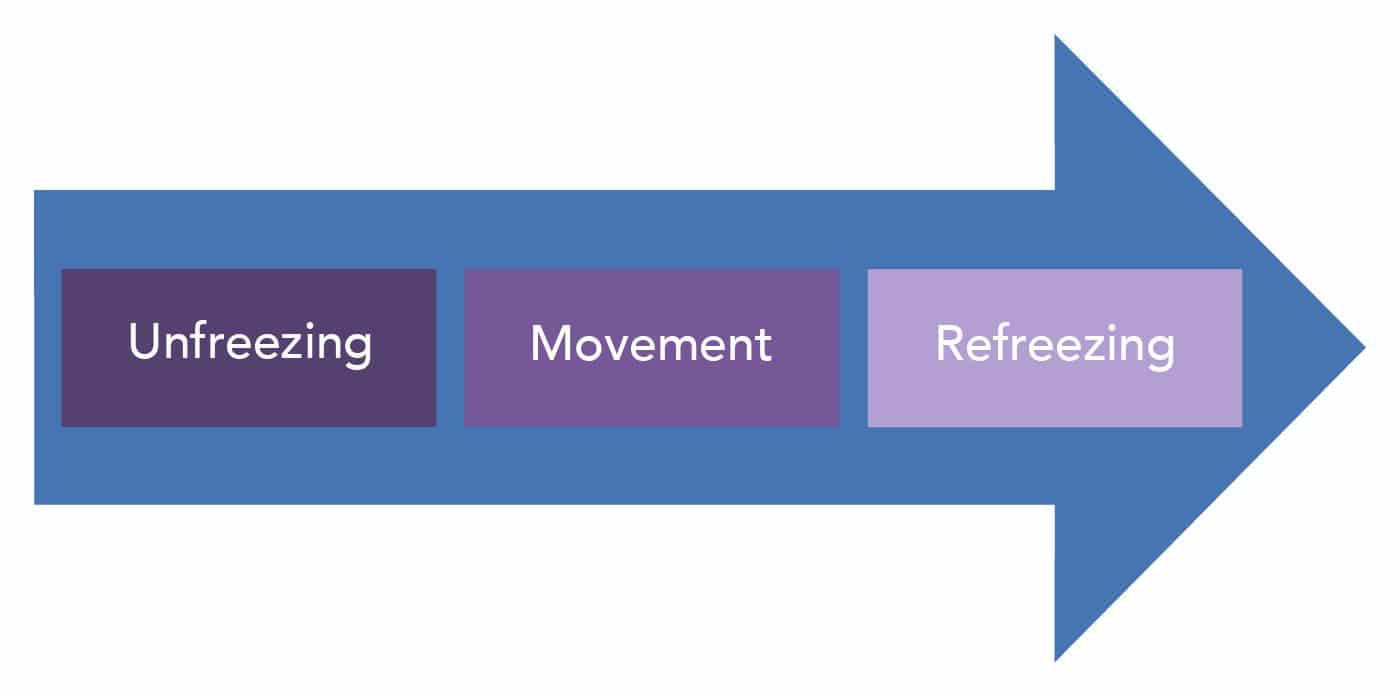Lewin’s Change Management Model is one of the most popular approaches used in Change Management. By splitting the change process into three stages you can break a large shift into manageable bitesize chunks which take into consideration both the processes and people.
Its author, Kurt Lewin, identified in 1947 three stages of change. He did so while referring to social systems in general. The first stage he called “unfreezing“. It involves overcoming inertia and dismantling the existing “mindset”. It is part of what he defines as surviving, and defence mechanisms are established. In the second stage, Change Happens. This is typically a period of confusion and transition. The old ways are being challenged but we do not have a clear picture as to what is going to come. The third and final stage he called “freezing“. The new mindset is crystallizing and one’s comfort is returning to the levels preceding the change. Most call this phase today as “refreezing“.
It’s interesting to notice that, although Lewin wrote about these stages, he never developed the full model, which instead appeared in management literature after his death.
If you want truly to understand something, try to change it.
Kurt Lewin
Let’s now see the method more in detail.
The Model

Unfreeze your process and perceptions
Upon realizing that your organisation needs to change, the first step is to “unfreeze” your current process and take a look at how things are done. This means analyzing every step and human interaction for potential improvements, no matter how in-depth you have to go and how much you need to discover.
By doing this you’re helping to uncover existing assumptions, biases and commonly accepted mistakes. This gives you the perspective you need to identify the cause of your problems, rather than just the symptoms.
Unfreezing also applies to your organisation’s perception of the upcoming change and its natural resistance to it. Forcing sudden change often only causes resentment and anxiety. Instead, preparing the team for change allows an understanding of how to mitigate resistance.
By focusing on the cause, you will have the content to explain to everyone what’s wrong with the current process, why it needs to change, what changes are being suggested and what benefits those changes will bring. This helps to mitigate the resistance issues that so often delay or impede change itself, and will encourage people to go along the transformation.
Make the changes
Once everyone is prepared and understands the causes of the issue, you’re ready to start deploying Change. In this process learning, communication, support and feedback are vital, as you want to support each individual in the transition and identify potential problems as soon as they arise.
This is why the model foresees Learning as a first activity, to ensure everybody in the time has the necessary tools to go through the change. If you changed a process, you need everyone to understand the necessary procedural steps for example. If it is software, people need to understand well how to use it.
Learning is more effective when it is an active rather than a passive process.
Kurt Lewin
You then need to ensure that everyone knows where to go for Support on any topic related to the change being put in place. This can take different forms and shapes, from meetings with managers to a support network, dedicated resources, or a knowledge base specifically developed to support Adoption.
Through the same support system you need to be able to collect Feedback, in order to promptly identify potential issues and intervene in a. timely matter.
Finally, Communication is required to glue the entire process together. You should communicate regularly with all team members in a transparent way (i.e. without hiding issues and problems). This will reinforce the positive loop of getting the necessary feedback and will allow you to identify shortcomings in training and support quickly.
Refreeze, creating a new status quo.
Once your change has been deployed, you need to “refreeze” the system again, creating a new “Status Quo”. This essentially means ensuring new habits are consolidated, and avoiding that old habits resurface. Carrying regular reviews will allow you to check the status of implementation. Rewards should be put in place to ensure the new model is fully implemented, and that people support and uphold the changes.
If feedback has been taken into account, this step is going to be easier, as it will show that you have invested in the change process.
What’s good about the model
The model key featurescan be summarized as follows:
- It emphasizes the importance of recognizing the need for change and being motivated to implement it.
- It acknowledges that resistance to change is inevitable.
- It focuses on people as the source of change and learning.
- It highlights the need to support new behaviors.
It makes it a great model for large scale change, as it excels in uncovering the issues that lie at the beginning of the process, and not only on the symptoms. This is also why most of the model lies at the core of any Change Management process, even if it is not named this way. This is especially seen in the concept of “AS-IS” and “TO-BE” analysis which is at the basis of most change processes.
Lewin’s model also has the advantage to thoroughly look at the conditions of when change happens. This lies at the core of Lewin’s credo, particularly his famous equation where behaviour is a function of a person and the environment. A strong basis for the entire domain of Organisation Development.
In hindsight, a lot go change programs that failed to deliver value, did so because some of the aspects of this model have not been understood or have not been implemented correctly. A typical example is the Learning and Communication aspect, or the focus on behaviors.
What’s bad about the model
It can be complicated to implement the full model for small process changes. However this does not invalidate the model per se, it just needs to push the project leader to “minimize” the process steps, without forgetting any of those. Again, the model is based on the effort to minimize change resistance behaviors, which might not be relevant in a small project.

What’s probably the biggest shortcoming in the model application is the fact that it suggests Change as a linear approach. In a period of massive transformation, Change succeeds in itself in rapid cycles. There’s not much time to consider the “Refreezing” part of the model.
Conclusion
For every large change project (for example an Organisational Design effort), Lewin’s Three Steps Change Model is a great way to consider all required steps.
You just need to keep in mind that not all changes require a massive investigation of the root causes. Plus, if you live in a cyclical change process, you will not have the time to spend on “refreezing”. This however does not alter the validity of the concept itself, especially its consideration of the human behaviors.
This post belongs to a series of articles related to Change Management. An introductory article: Change Management: The 10 Best Approaches & Models is available, containing links also to all other posts of the series.

Cover Photo by Priscilla Du Preez on Unsplash

[…] Eight Steps Process for Leading Change can be considered an expansion of Lewin’s three-step model, albeit being more detailed and focusing more on the people (particularly Leaders) behind it. The […]
[…] than a Change Management like Lewin’s or Kotter’s, the McKinsey 7-S Framework is a helpful diagnostic tool to initiate and sustain […]
[…] on Leadership, is based on the research done by Kurt Lewin in the 1930s (in parallel with his investigation of Change). He identified three archetypes of […]